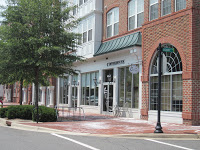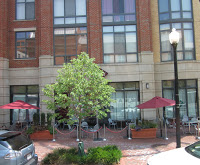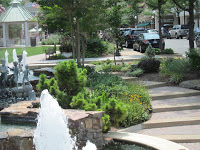Mixed-use projects offer model for redevelopment in Beauregard Corridor
 |
| Cameron Station |
Residents of the Beauregard Corridor in Alexandria’s West End took a bus tour last Saturday to explore mixed-use projects in Old Town and Arlington that incorporate some of the elements proposed for their community.
The projects featured on the tour, hosted by the Beauregard Developer Stakeholders group, could also be considered models for the revitalization of Annandale.
The townhouses at Cameron Station, on Duke Street in Alexandria’s West End, are similar to those proposed for the JBG and Shirley Gardens properties in the Beauregard Corridor.
Positive elements pointed out by the developers and planners include wide sidewalks and large front stoops. Parking is inside the blocks, so cars are easily accessible but hidden from the streetscape, which makes the facades more attractive and makes the community more pedestrian friendly.
 |
| Cameron Station retail |
The shopping area in Cameron Station was not well planned, though, and as a result, there has been high turnover, said retail consultant Jon Eisen. The shops are buried within the community, so people who don’t live there don’t know about them.
Jeff Farner, deputy director of Alexandria’s Department of Planning and Zoning, cited some design problems with the shops, including the lack of awnings and galleries to provide shade. Another shortcoming pointed out by the developers is the lack of enough ways to get in and out of the neighborhood.
Next stop was Old Town Alexandria, where the developers said they like some aspects of the Carlyle development (on Duke Street at Dulaney and John Carlyle streets), including well-concealed parking and the use of varied building facades. “A larger building needs to be articulated into small sections that break up the facade,” said Farner.
 |
| John Carlyle Street |
The retail was not well planned, though. The shops are mostly placed around a too-large open space, which makes them too far away from one another, said Catharine Puskar, with the land use law firm Walsh Colucci Lubely Emrich and Walsh. She said it’s better to have shops clustered together.
After looking at other housing developments in Old Town, the bus headed to Market Common Clarendon, a mixed-use project at the 2800 block of Clarendon Boulevard in Arlington. The developers liked the way parking was placed behind or above the stores. They also liked the pedestrian-only shopping area and the small “pocket park” that serves as an “urban backyard” for people who live in multifamily units above the shops.
 |
| Market Common Clarendon |
Eisen liked the idea of clustering similar businesses together. For example, there were several home goods stores next to one another, while the main street was mostly lined with restaurants.
The benefit of mixed-use development is reduced traffic, he said, because people shop and work where they live.
The bus headed up Columbia Pike in Arlington, where a form-based code approach was adopted in 2003, giving developers more flexibility to be innovative. Six projects have been built since then, and Puskar said that stretch of highway will eventually look more like the higher-density areas of Arlington.
A form-based approach has been approved for Annandale. It is included in the Annandale revitalization plan approved as an amendment to the county’s comprehensive plan by the Board of Supervisors a year ago.
 |
| Shirlingon |
The final stop on the bus tour was the Village at Shirlington, a lively stretch of restaurants, bars, and stores at 2700 South Quincy Street in Arlington. Again, parking is in the back and is accessible from the main street via alleys, known as “paseos.”
The Beauregard Plan Area includes the BRAC-133 complex, the Mark Center shopping area, Southern Towers, the Hamlets, several other garden apartment and townhouse developments, and at least half a dozen office buildings.
The six major property owners in the area are working on a plan for higher-density, mixed-use development to include 2,400 additional housing units in the next 10 to 15 years, plus a couple of hotels, more office buildings, a traffic ellipse at the intersection of Beauregard and Seminary, and a new network of streets. A new fire station is slated for the corner of Beauregard and Sanger.
Approximately 500,000 square feet of retail is planned for the Beauregard Corridor, with most of it in a proposed town center. There will probably be a grocery store and drug store, with other stores to be determined. Possibilities include a movie theater, gym, clothing stores, and home goods stores.
Development isn’t expected to start for three or four years, said Farner.
Meanwhile, the Beauregard Corridor Stakeholders Group, the developers, and Alexandria officials have been working on a vision and guiding principles for the redevelopment of the area. Some of the priorities identified by the stakeholders group include affordable housing, a network of trails connecting neighborhoods, environmental sustainability, parks, open space, and a pedestrian bridge over Seminary Road.


I took this tour and attended the Beauregard Corridor Stakeholders Group meeting last night (July 25th).
Clearly, the City of Alexandria is justifiable proud of its accomplishments in creating attractive, well maintained walkable community villages throughout Alexandria.
With the exception of the BRAC-133 development, the City has done a good job in considering traffic flow, parking, shopping and affordable housing in the development of these urban village communities.
Although BRAC-133 was Alexandria's mistake, it does not have to become a disaster for Columbia Pike, Rt 50 and Rt 7 as commuters seek alternatives to the forecasted long stretches of standing traffic on I-395.
The City of Alexandria is focusing considerable attention and resources on preventing congestion along Beauregard and Seminary Rd before BRAC reaches full occupancy in 2012. Fairfax County must do more than having meeting, keeping up with events and waiting until traffic congestion along Columbia Pike, Rt 50 and Rt 7 reaches a crisis.
Metaphorically, the time to get a backup parachute is now, not after the primary chute fails to open.